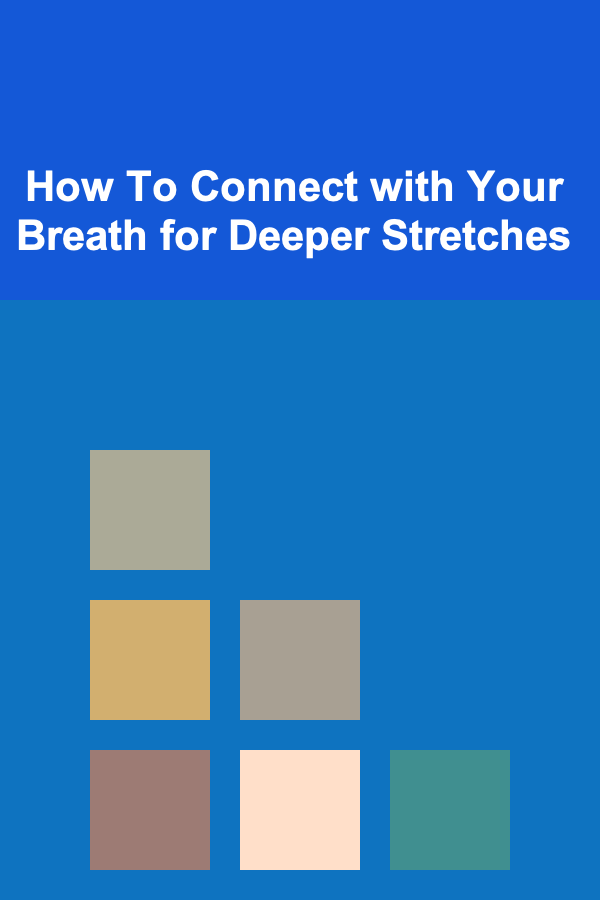
How To Connect with Your Breath for Deeper Stretches
ebook include PDF & Audio bundle (Micro Guide)
$12.99$10.99
Limited Time Offer! Order within the next:

Breath is a powerful tool. It's essential for life, yet many of us go through our daily activities without being fully aware of it. The connection between breath and movement is not only vital for our well-being, but also for improving flexibility and achieving deeper stretches during yoga or other forms of exercise. This article explores how to harness the power of your breath to enhance your stretching routine, allowing you to go deeper, feel more grounded, and achieve better overall results.
The Role of Breath in Stretching
When we stretch, the muscles are being lengthened, which can often cause tension, discomfort, and even resistance. The body's response to these sensations can be a barrier to achieving deep stretches. However, breath can help us overcome this resistance by promoting relaxation, easing muscle tension, and improving circulation. When combined with mindful breathing, stretches become more than just physical movements; they turn into an active process of releasing tension and allowing the body to open up.
Physiological Benefits of Breathing During Stretching
Breathing is intricately linked to the autonomic nervous system, which controls our body's involuntary functions, such as heart rate and digestion. In terms of stretching, breath has the ability to influence this system in ways that support relaxation and deeper flexibility.
- Increases Oxygen Supply: Deep breathing increases the oxygen flow to your muscles, enabling them to relax and lengthen more easily. This can enhance the quality of the stretch and decrease feelings of tightness or discomfort.
- Reduces Tension: Breathing deeply activates the parasympathetic nervous system, which is responsible for the "rest and digest" response. This calms the body and reduces the fight-or-flight response, helping your muscles to let go of tension and allowing you to stretch deeper.
- Enhances Circulation: Deep breathing encourages better blood flow and circulation, which helps to release lactic acid build-up in muscles after a workout. This can lead to a reduction in muscle stiffness and soreness, improving overall flexibility over time.
- Improves Focus and Mindfulness: Breath can also serve as a focal point, bringing awareness and attention to the present moment. This mindfulness helps you to tune into your body, becoming more aware of subtle shifts in your stretch and preventing overstretching or injury.
Understanding the Different Types of Breathing Techniques
To connect with your breath effectively during stretches, it's essential to understand different breathing techniques and how they can be applied. Here are some common breathing methods that can deepen your stretches:
1. Diaphragmatic Breathing (Belly Breathing)
Diaphragmatic breathing is the foundation of many stretching practices. By breathing deeply into your belly (rather than shallow breathing into your chest), you can activate the diaphragm and allow for full lung expansion. This helps create a sense of relaxation and opens up the torso, which can facilitate deeper stretches.
How to practice diaphragmatic breathing:
- Inhale slowly through your nose, allowing your belly to rise as your diaphragm expands.
- Exhale gently through your mouth, allowing the belly to fall.
- Focus on the sensation of the breath moving through your body, feeling the stretch with each exhale.
2. Ujjayi Breath (Victorious Breath)
Ujjayi breath is a specific type of breathing used in yoga that creates a gentle ocean-like sound. It's performed by slightly constricting the back of the throat, which slows the breath down and encourages a steady rhythm. This technique helps to focus the mind, reduce anxiety, and maintain consistency in the breath throughout your stretches.
How to practice Ujjayi breath:
- Inhale deeply through the nose, slightly constricting the back of the throat to create a soft "ha" sound.
- Exhale slowly through the nose with the same constriction, maintaining the sound.
- Use Ujjayi breath during each stretch to regulate the pace and ensure controlled, steady breathing.
3. Box Breathing (Square Breathing)
Box breathing, or square breathing, involves inhaling, holding the breath, exhaling, and holding again, each for equal counts. This technique helps to calm the mind, increase focus, and reduce any feelings of discomfort or resistance during a stretch.
How to practice box breathing:
- Inhale for a count of 4.
- Hold the breath for a count of 4.
- Exhale for a count of 4.
- Hold the breath again for a count of 4.
- Repeat for several cycles to bring calmness and steadiness to the stretch.
4. Alternate Nostril Breathing (Nadi Shodhana)
Alternate nostril breathing is a technique often used to balance the body's energy and calm the mind. By breathing alternately through each nostril, this technique brings focus and balance, which can be particularly helpful when trying to relax into a stretch or reach a more difficult position.
How to practice alternate nostril breathing:
- Sit in a comfortable position and place your right thumb on your right nostril, blocking it.
- Inhale deeply through the left nostril.
- Close the left nostril with your right ring finger and release the right nostril.
- Exhale slowly through the right nostril.
- Inhale deeply through the right nostril.
- Close the right nostril and exhale through the left nostril.
- Repeat for several rounds.
The Breath-Stretch Connection
Now that we understand various breathing techniques, it's time to explore how breath directly impacts the quality of your stretches.
1. Inhale to Lengthen, Exhale to Deepen
A general rule of thumb when connecting breath to stretch is to use the inhalation to lengthen the body, and the exhalation to deepen into the stretch. When you inhale, visualize the space between your bones and muscles lengthening, creating room for deeper movement. On the exhale, allow your muscles to release, softening into the stretch.
For example, in a forward fold, as you inhale, lengthen through the spine, lifting your chest. As you exhale, soften into the stretch, folding deeper. The exhalation serves as a trigger to let go of any resistance or tightness, allowing the body to go deeper.
2. Pacing with the Breath
It's important not to rush into stretches. The breath should dictate the pace of your movements. For example, if you're doing a deep hamstring stretch, allow yourself to move gently with each inhale and exhale, rather than forcing the stretch. Each inhale creates length, and each exhale brings the body closer to its maximum range of motion.
This method of pacing helps prevent overstretching and injuries while ensuring you maintain the alignment of your body.
3. Breathing Through Discomfort
Stretching, especially at deeper levels, can be uncomfortable. The goal is not to push through pain but to breathe through discomfort. When you encounter a stretch that feels intense, rather than holding your breath, deepen your connection to it with slow, steady breathing. As you breathe, visualize the muscles relaxing and releasing tension.
A key concept here is not to allow the discomfort to lead to muscle tension. Instead, use the breath as a guide, exhaling deeply through the tightness and allowing the stretch to soften.
How to Incorporate Breath Awareness into Your Stretching Routine
1. Start with a Warm-Up
Before attempting deeper stretches, it's essential to warm up your body and engage in some gentle breathing exercises. Start by doing light stretches and practicing deep breathing. This will prime both your body and mind, allowing you to enter into deeper stretches more easily.
2. Create a Breathing Cue
It can be helpful to create a breathing cue or mantra for your stretches. For example, during a forward fold, you could mentally say, "Inhale to lengthen, exhale to deepen." This reminder brings focus to your breath and helps guide your movements.
3. Pay Attention to Your Body's Signals
While breathing can deepen your stretches, it's crucial to pay attention to your body's limits. Stretch to a point where you feel a gentle pull, not pain. If you feel sharp pain, back off the stretch and reassess your alignment. Breath can help you stay attuned to these signals by bringing your attention inward.
4. Cool Down with Breathing Exercises
Once you've completed your stretching routine, take some time to cool down and integrate your breath. Gentle, restorative breathing can help relax the muscles further and reduce post-workout soreness. Try lying on your back with one hand on your chest and the other on your belly, and focus on deep belly breaths.
Conclusion
Breathing is a simple, yet powerful tool that can transform your stretching routine. By connecting with your breath, you not only enhance your flexibility but also foster a deeper sense of relaxation and mindfulness. Whether you're using diaphragmatic breathing, Ujjayi breath, or simply syncing your movements with your breath, the practice of mindful breathing during stretching can help you go deeper, stretch more effectively, and achieve greater physical and mental balance.
The next time you stretch, remember to breathe with intention, and allow your breath to guide you into deeper and more rewarding stretches.
Reading More From Our Other Websites
- [Organization Tip 101] How to Use Mindful Affirmations for Positive Thinking
- [Home Renovating 101] How to Use Home Renovation Apps to Streamline Your Projects
- [Trail Running Tip 101] Nature's Pulse: Using Trail Sounds as a Moving Mantra During Runs
- [Home Rental Property 101] How to Determine if Houses for Rent with a Built-In Sound System Are Worth the Extra Cost
- [Home Holiday Decoration 101] How to Decorate with Holiday-Themed Throw Pillows
- [Home Budget Decorating 101] How to Turn Your Backyard into a Stylish Space on a Budget
- [Personal Finance Management 101] How to Invest Like a Millennial: Tips and Strategies
- [Personal Investment 101] How to Develop a Personal Investment Plan That Fits Your Financial Goals
- [Trail Running Tip 101] Top 7 Scenic Solo Trail-Running Destinations You Must Explore
- [Personal Investment 101] How to Understand Bonds and Their Role in Your Portfolio

How to Create a Neighborhood Watch Program in Your Community
Read More
How to Encourage Team Participation in Supply Organization
Read More
Remote Job Search: What Skills Are Most In-Demand?
Read More
How to Paint Miniature Figurines: Achieving Vibrant and Consistent Colors
Read More
How to Hand Letter Vintage Movie Titles
Read More
How to Embroider Celestial Embroidery Designs
Read MoreOther Products

How to Create a Neighborhood Watch Program in Your Community
Read More
How to Encourage Team Participation in Supply Organization
Read More
Remote Job Search: What Skills Are Most In-Demand?
Read More
How to Paint Miniature Figurines: Achieving Vibrant and Consistent Colors
Read More
How to Hand Letter Vintage Movie Titles
Read More